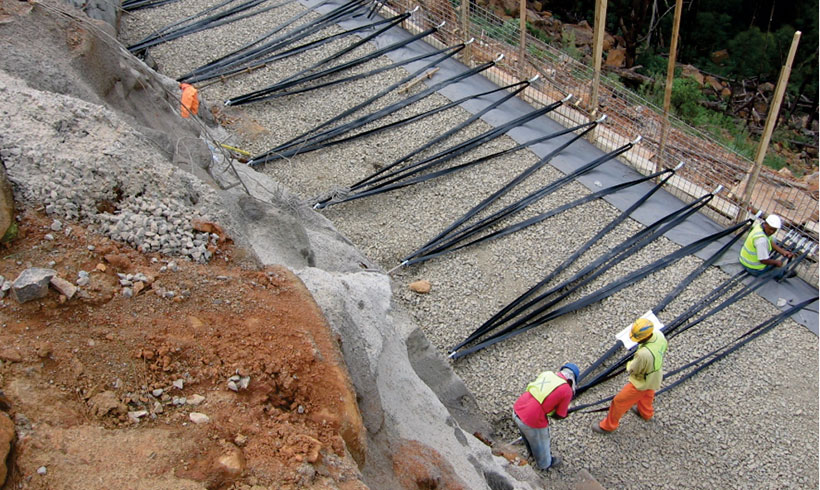7 Simple Techniques For Geotechnical Engineering For Construction Projects
7 Simple Techniques For Geotechnical Engineering For Construction Projects
Blog Article
About Geotechnical Engineering For Construction Projects
Table of Contents8 Easy Facts About Geotechnical Engineering For Construction Projects ExplainedThe smart Trick of Geotechnical Engineering For Construction Projects That Nobody is DiscussingWhat Does Geotechnical Engineering For Construction Projects Do?Geotechnical Engineering For Construction Projects - An OverviewIndicators on Geotechnical Engineering For Construction Projects You Should KnowRumored Buzz on Geotechnical Engineering For Construction Projects
The role of geotechnical design substantially manages recognizing the attributes of soil and rock, which might vary considerably by their density, dampness content etc. These attributes have to be analyzed by geotechnical designers to forecast their movements under different conditions. The safety and security as well as stability of frameworks are affected by soil problems, making this evaluation needed., in enhancement to how they engage with building and constructions that have been erected on or within them, is one of the key explanations for why geotechnical design is essential.
Along with structural planning and building and construction, geotechnical design is likewise crucial to the repair and maintenance of pre-existing frameworks. Age-related degradation or added troubles can affect a framework's stability and effectiveness. Environmental defense is accomplished through geotechnical design. Expertise in air, water, and soil high quality upkeep is used by geotechnical engineers to minimize the adverse impacts of projects.
To sum up, geotechnical engineering is an essential discipline that preserves the strength and integrity of civil facilities. Geotechnical engineers contribute to making building tasks reliable all over the world by understanding the behaviour of earth materials and applying appropriate planning strategies.
The Greatest Guide To Geotechnical Engineering For Construction Projects
By checking out soil, rock, and subsurface problems, geotechnical engineers provide crucial understandings that aid in the style, building, and upkeep of structures and facilities.

Not known Incorrect Statements About Geotechnical Engineering For Construction Projects
Laboratory testing: Figuring out the residential properties of soil and rock. Area testing: Conducting examinations on-site to analyze conditions. Evaluation and design: Making use of data to design foundations, keeping wall surfaces, passages, and various other structures. Several high-profile building tasks have effectively utilized geotechnical engineering to ensure their security and safety and security. For example:: The world's tallest building called for a deep understanding of the underlying geology.
As a leader in geotechnical design, BECC Inc. is committed to supplying cutting-edge and reliable solutions that fulfill the greatest standards of quality and safety., a mechanical engineer and geologist.
The Definitive Guide for Geotechnical Engineering For Construction Projects
Terzaghi likewise established the structure for theories of birthing capacity of foundations, and the theory for prediction of the price of settlement of clay layers because of loan consolidation. After that, Maurice Biot fully established the three-dimensional soil combination theory, extending the one-dimensional design previously created by Terzaghi to more basic hypotheses and introducing the set of fundamental equations of Poroelasticity.
Geotechnical designers check out and establish the residential properties of subsurface conditions and materials. They additionally create equivalent earthworks and keeping structures, passages, and framework structures, and may oversee and review websites, which may additionally involve site monitoring in addition to the risk evaluation and mitigation of natural dangers - Geotechnical Engineering for Construction Projects. Geotechnical engineers and design geologists carry out geotechnical investigations to acquire info on the physical residential or commercial properties of soil and rock hidden and beside a website to make earthworks and foundations for suggested structures and for the repair work of distress to earthworks and structures triggered by subsurface problems.
Geotechnical Engineering For Construction Projects Can Be Fun For Anyone
Still, they are often made use of to enable a rock hound or designer to be reduced right into the borehole for direct aesthetic and manual exam of the dirt and rock stratigraphy. Various dirt samplers exist to meet the requirements of various design tasks. The standard infiltration examination, which makes use of a thick-walled split spoon sampler, is one of the most usual means to collect disrupted examples.

If the interface in between the mass and the base of an incline has a complicated geometry, incline stability analysis is challenging and mathematical option techniques are required. Usually, the interface's exact geometry is unknown, and a streamlined interface geometry is presumed. Finite slopes call for three-dimensional models to be examined, so most inclines are evaluated thinking that they are infinitely broad and can be stood for by two-dimensional designs.
The Facts About Geotechnical Engineering For Construction Projects Uncovered
The observational method may be you can look here called adheres to: General exploration enough to establish the harsh nature, pattern, and properties of down payments. Assessment of the most likely conditions and one of the most unfavorable possible variances. Developing the design based upon a functioning hypothesis of behavior prepared for under the most potential problems. Choice of amounts to be observed as construction profits and determining their prepared for values based upon the functioning theory under the most undesirable conditions.
Dimension of amounts and evaluation of real conditions. Style modification per real problems The empirical approach appropriates for building and construction that has currently begun when an unanticipated growth occurs or when a failing or accident looms or has actually already happened. It is inappropriate for tasks whose helpful site layout can not be changed throughout construction.
Report this page